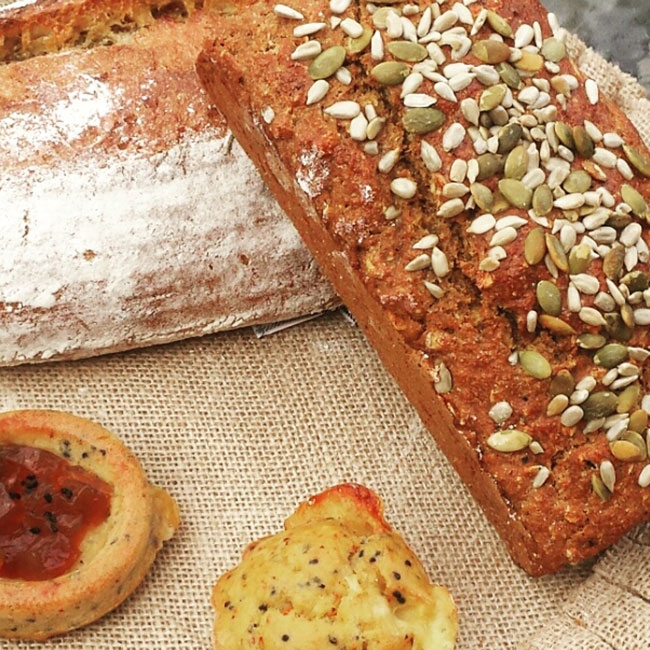
The Final Proof: Beer inspired baking
February 28, 2018
By
Jane Dummer
Craft beer and all its complexity makes a great pairing with different types of bread.
 The inactive yeast in beer is an instigator for the yeast used in breads. Photo credit: Jane Dummer
The inactive yeast in beer is an instigator for the yeast used in breads. Photo credit: Jane DummerCraft beer as a drink is obvious; however that same beverage as a fantastic ingredient for both sweet and savoury baking is growing in popularity. Craft beers are diverse and complex with flavours that range from malt and barley to dried fruits and citrus.
These flavours that make beer taste good add delicious depth and moisture to breads and sweets. The inactive yeast found in beer works to activate yeast used in breads. The one common theme is the quality of the beer. Be it stout or ale, the better the quality of the beer, the better the bread. This is one of the many things I was taught at the Baking with Beer class hosted by Muskoka Brewery and ACE Bakery in Toronto last fall.
Julien Bruyer, product development specialist for ACE Bakery and co-facilitator of the class, says “It’s important to match the beer to the type of bread. For example, think about the flavour, colour and aroma. For sourdough bread, you want strong ale with a hoppy flavour, and for sweeter bread you want a stout to add a sweet richness.”
In the class, we used Muskoka’s Harvest Ale for the sourdough bread and their Shinnicked Stout for the soda bread, both very different but equally scrumptious. Bruyer explains: “For the sourdough bread the ale replaced the water for the starter, which gave the bread the aromas and flavours of that beer. We experimented and found a longer fermentation of five hours resulted in a nice dark bake with a crisp texture on the outside and a soft chew on the inside. For the soda bread, the grains and seeds were soaked in the oatmeal based Shinnicked Stout for 24 hours resulting in a full body flavour perfect for pairing with aged cheddar or salmon.”
Beer is accessible, cost effective and low in alcohol compared to liquor or wine when in the product development stage. Baking with beer is all about experimenting. Shannon Mulligan, marketing specialist at Muskoka Brewery says “Baking with beer is an economical way to explore the interesting flavours and complexity of craft beers. Even though total beer sales are down, the craft beer segment is up.”
The LCBO identified in 2015-2016, Ontario craft beer remained on trend, with sales rising 36 per cent.
As a red wine drinker, my beer journey started with craft beer in Austria in the early 2000s and since then I’ve be open to new, unique varieties of local craft beers. Mulligan agrees. “We have a variety of approachable to complex beers, making it easy to find a beer that can become your favourite. Due to this, our target market is becoming larger. Baking with beer is an opportunity for non-beer drinkers to enjoy the craft beer in a food while becoming more comfortable the flavours and aromas. Our top baking beers are Shinnicked Stout, Harvest Ale and Winterweiss. And we encourage experimenting and having fun with baking to find the beer that best matches your final bread or sweets.”
As you start to experiment, Bruyer has three must-dos to remember. “Beer needs to be at room temperature to proof properly, never use it cold. The beer will replace most of the liquids in the recipe, so adjust it accordingly. And the type of beer and length of fermentation will affect the colour of the final bake, therefore choose wisely depending on the bread or sweet you are baking.” As we swing into the spring season, Bruyer suggests experimenting with beers with fruity and citrus notes. “I’ve created croissant dough with fruit variety of beer and the flavour was delicious. It was the perfect taste complement with your morning coffee.”
The idea of baking with craft beer is to achieve an amalgamation of the flavours. Hoppy beers are ideal for sour or savoury breads. Stout beers are perfect for sweeter breads. This is a wonderful space for existing craft beer drinkers to marry their love of beer with baking and to offer the opportunity for non-beer drinkers to explore the quality ingredient of craft beer in their baking. Follow Bruyer’s simple suggestions, stay inspired and keep experimenting with quality craft beer to bring your baking to a new delicious flavours, colours and aromas.
Jane Dummer, RD (www.janedummer.com), known as the Pod to Plate Food Consultant, collaborates and partners with the food and nutrition industry across North America.
Print this page
Leave a Reply